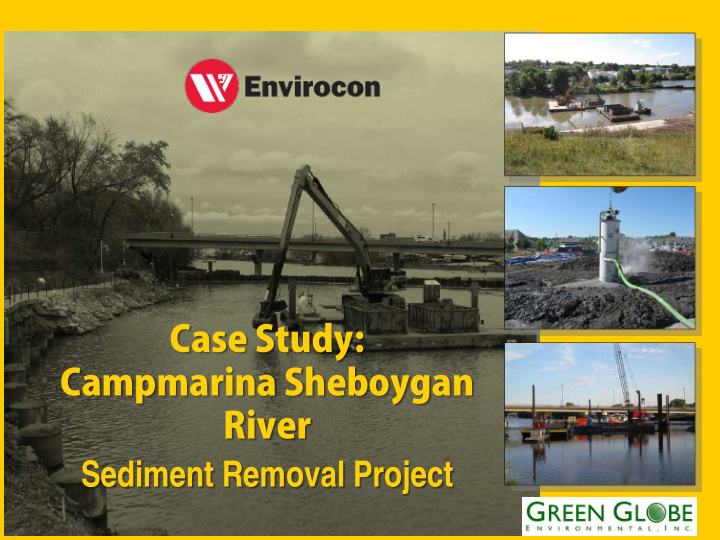



Case Study: Campmarina Sheboygan River Sediment Removal Project
Project I ntroduction � Sheboygan River, Sheboygan, Wisconsin � Parties � Owner: Wisconsin Public Service � Contractor: Envirocon, Inc. � Engineer: Natural Resources Technology � Key Subcontractors: McMullen & Pitz, Gillen, & Green Globe Environmental � Former MGP Site � COC’s: TSCA & Non-TSCA PCB’s, NAPL, & PAH impacted sediments � Existing Waterloo Wall from earlier Superfund project � Site is a city park in a residential neighborhood
Scope of Work � Remove 20,113 BCY of impacted sediments by mechanical dredging using a CAT 345 on sectional barges (flexifloats) � TSCA PCB’s: 1,177 BCY, “Surgically Removed” � Non TSCA PCB’s, PAH’s, & NAPL: 18,936 BCY � Supplemental: 6,000 BCY, only 900 BCY (North Supplemental) removed � Stabilize sediments for off site disposal (TSCA to a hazardous waste facility, Non-TSCA to a non-hazardous landfill) � Install buttress system for waterloo wall � Ancillary work items: Install and remove sheet pile coffer dam, restore bank, remove Wakefield Wall, treat up to 2.6M gallons of water, control sediment odor
Site Overview Site Laydown H 2 O Treatment Stabilization Pad Buttress System Dredge Boat I sland Sheetpile Coffer Condos
Design Overview
Key Topic Areas Existing Waterloo Barrier & Cap � Setting: residential neighborhood & city park � Waterloo barrier and cap = LGP, mats & deflection monitoring Project Coordination & Sequencing � No TSCA / Non TSCA cross contamination � Buttress of waterloo barrier before sediment removal Odor Control � NAPL, PCB, and PAH impacted sediments, NAPL being most odorous from coal tar � Air monitoring (suma canisters), dust monitoring, and odor control measures Water Treatment � TSS (total suspended solids) removal key to prevent PCB exceedance � Batch filtration proved effective Guidance System Issues � Hypack Dredgepack used on the mechanical dredges � Change implementation on complex site models
Sequencing & Logistics Key Challenges: � Installation of sheet pile coffer dam � Removal of TSCA material separate from Non-TSCA material � Stabilization of sediments � Installation of buttress system / deflection monitoring / LGP on the cap & wall � Removal of Wakefield Wall � Work coordination with a separate but adjoining dredging project
Coffer Dam Construction Sheet pile coffer dam was used to contain suspended solids, especially in areas with TSCA PCB contaminated sediments. Details � 2 wings, North & South � Between Boat Island & East Shore � 35’ long Z pile � Vibrated in place � Installed by M&P � Buttress install and dredging simultaneous with coffer dam install
Buttress Construction � Existing Waterloo wall was not tied into bedrock. There was concern that the existing capped and remediated Superfund site (the park) could deflect when removing sediments against it, breaking the grouted joints and causing leaking into the river. Deflection monitoring and LGP measures implemented on the Waterloo wall and cap � Impacted sediments removed by jetting along the Waterloo wall to allow for the installation of the wales � Buttress System: 42” diameter steel pipe, 40’ long, double I-beam wales between Waterloo wall and 42” pipe � A wood wakefield wall was discovered along the buttress alignment. Much of the wall had to be sheared off.
Odor Control Given the Site location in a residential area and the odorous nature of the NAPL MGP coal tar residuals (much like moth ball odors), extensive control measures were taken. Key Control Measures: � Rusmar foaming of pile � Ecosorb “Air Fresheners” � Tarping of the pile LKD was used to stabilize the sediments to pass the paint filter test. One consequence of LKD addition is that it heats the pile which promotes off-gassing. Approximately 2,000 BCY of sediments were stored and stabilized on the pile at any given time.
Water Treatment System � Plant sized to handle 50 GPM and 2.6M gallons over the project duration � Plant treated water from: stabilization pad, free liquids at the sediment offload, decontamination water � Key components: positive displacement pumps and piping, geotubes, weir tanks, bag filters, sand filters, and carbon filters Permit Requirements: � PCB Total: 0.8 mg/L daily maximum � PAH’s: 0.1 mg/L monthly average � TSS: 10 mg/L daily maximum
Water Treatment System PFD
Guidance System & Technology Solutions � Numerous design changes, meant numerous model changes � Existing grade updated using Hydrolite Single Beam Sonar, multiple times per week. Sonar used for both QA and QC bathymetric surveys. Model Changes Final grade models consisted of: � TSCA by cut from OG � TSCA PCB’s: 0.5’ x 0.5’ grid � TSCA cut to provided pts � NAPL: flat bottom elevations � NAPL: Visual depths � PAH’s: contoured grades � PAH’s: 3 added contours � DTM implications and horizon Modeling methods: � Hypack does not import TIN lines. surfaces from Autodesk Civil 3D. Models were created in Civil 3D. Then a 0.5’ x 0.5’ grid was lifted from the designed surface. This XYZ file was then used in Hypack/Dredgepack � Civil 3D does not quickly make the grid but several add-ins do.
Guidance System & Technology Solutions � SPS 852 base station (GNSS enabled), 450 mhz radios (Trimmark 3), GNSS enabled RTK receivers, 880 Extreme rover and SPS 700 robotic total station, Hydrolite Sonar. Etrac sensors for the guidance system. � Complex models. NAPL was cleaned until visually removed (core samples). Depth revised throughout. Vertical edges, no laybacks. Tolerances were at grade to -0.5’ below grade. � “Surgical Removal” of TSCA areas � Software solutions: Autodesk Civil 3D, Terramodel, Logmein, and Hypack
Questions?
Recommend
More recommend